The Pareto Principle is something that most of us are familiar with, at least intuitively, and very likely from experience. Here is a good working definition, copied directly from Wikipedia”:
“The Pareto principle (also known as the 80/20 rule, the law of the vital few and the principle of factor sparsity) states that for many outcomes, roughly 80% of consequences come from 20% of causes (the “vital few”).”
This website gives a good introduction, and the following graph was copied from here:
https://betterexplained.com/articles/understanding-the-pareto-principle-the-8020-rule/

In a “fair” world (whatever that means…), outcomes (for example, the amount of money someone earns) would be directly proportional (a 1-to-1 correspondence, depicted by the red line in the graph) to the amount of effort (or time, focused work, etc.) that person puts into to their job (or business, project, etc.). But this ideal of “fairness” is so far from reality, that virtually anybody with a functioning brain over the age of 10 (or so) has learned by first-hand experience, or at least by observation, that concepts such as these apply:
Work smarter, not harder
The Law of Diminishing Returns (think of a graph with an asymptote, where more and more effort leads to less and less returns per unit effort, analogous to an object with mass accelerating to near the speed of light with the equations E=mc^2)
The first rule of any technology used in a business is that automation applied to an efficient operation will magnify the efficiency. The second is that automation applied to an inefficient operation will magnify the inefficiency. — Bill Gates
We know that efficiency and effectiveness are increased when you’re getting sufficient sleep, and it will take you longer to do the same thing on an underslept brain, which means you end up having to stay awake longer. So goes the vicious cycle. — Matthew Walker
Quotes below here extracted from “Advice from Old People”:
https://www.youtube.com/watch?v=u0Ptw0r0Pq0
Rowing harder doesn’t help if the boat is headed in the wrong direction.
Striving for success without hard work is like trying to harvest where you haven’t planted
No one is too busy; it’s only a matter of priorities
Excuses make today easier but tomorrow harder. Discipline makes today hard but tomorrow easier.
Do not go where the path may lead; go instead where there is no path and leave a trail.
Life’s most significant achievements often emerge from the depths of adversity.
What comes easy won’t last, what lasts won’t come easy.
Discipline is choosing between what you want now and what you want most.
Done is better than perfect.
It’s a slow process, but quitting won’t speed it up.
Mistakes are stepping stones, not stumbling blocks. Learn from them and move forward.
Playing it safe is the most dangerous thing you can do in life.
The only real mistake is the one from which we learn nothing.
Your future needs you; your past doesn’t.
Your past is a place to learn and grow, not a place to live.
You grow mentally weak when your life is too comfortable.
If you get tired, learn to rest, not to quit.
Self-care is not selfish; it’s essential for a balanced and fulfilling life.
Take care of your body; remember health is another form of wealth
If someone tells you you can’t, they’re showing you their limits, not yours.
Silence is the best answer to someone who doesn’t value your words.
If you live for people’s acceptance, you will die from their rejection.
So why all this philosophizing? Because I have reached, and tried very hard to exceed my physical limits with saving and sharing tomato seeds. As I’ve stated or hinted at in recent blog posts; it is physically impossible for me to work 100 hours per day, no matter how hard I try.
A 50% increase in seed sales does not mean that I am awarded a 50% increase in the number of hours allotted to me every day; I was already stretched to my limits. In reality, demand for seeds has more than quadrupled in the past five years – and I was already super busy. So far in 2024, I have been caught up with filling seed requests for a grand total of less than 10 hours, with none of these being consecutive.
I have been putting in 100+ hours a week, 52 weeks a year, for over 13 years now. But I need, I “must” put in at least 100 hours every day, 365 days a year to keep up with everything that I “should” and intend and want to do. Ambitions far exceed abilities. I’m not a person inclined to braggadocio; but there is one thing I brag about often, and not entirely facetiously:
I am better at this than perhaps anybody you will ever meet in your life:
OVERESTIMATING MY ABILITIES
How many times have I used the term “triage” in recent blog posts?
On the bright side, as of March, 2024 for the first time since 2011, Delectation of Tomatoes is debt free, and I’m no longer paying interest! Many thanks to the hundreds of gardeners from around the world who have been supporting my efforts to procure, propagate, provide, and disseminate seeds of tomato (and other) varieties from around the world!
It’s a huge relief to at least feel like I am no longer working largely to pay interest to banks, credit card companies, etc. I have even been able to “splurge” a little bit, such as by purchasing a bedframe; for the first time in almost a decade, I have been sleeping on a mattress placed on a bed instead of on the floor. This makes for a convenient supplemental “table” when working as well!
Unfortunately, business expenses have been going up at a rate almost, but not quite, as fast as income. Profit margins remain extremely low and, after business expenses, making anything even close to minimum wage remains a remote pipe dream.
Also, an embarrassing and shameful milestone has been reached this month: that “century mark” of 100 pounds of weight gain since I started Delectation of Tomatoes. I’ve been tracking my weight frequently over the years. Before starting Delectation of Tomatoes, I was running 40-80 miles per week, racing marathons (I once had Olympic ambitions…) and other road races, bicycling, etc. But deliberate exercise was the first of hundreds of “luxuries” that I let go of as I focused more and more on trying to prevent Delectation of Tomatoes from being an utter failure.
Like clockwork, I LOSE ten pounds every growing season (May through October, while working outside, keeping active, getting fresh air and sunshine, sleeping reasonably well). Then regrettably, every off-season (November through April, while processing seeds indoors, filling seed requests, planting seeds, working many hours at the computer, getting no sunlight or outdoor activity), I GAIN 15-20 pounds. I’ll let you do the math.
Along with this annual yo-yo but trending heavily upwards weight gain, come all of the concomitant (and perhaps predictable) negative correlates:
– Severe Metabolic dysfunction–associated steatotic liver disease (MASLD)
– Extreme Chronic Fatigue Syndrome
– Several severe sleep disorders (e.g., at 3:00 a.m. on any given morning, I am more likely to be working on filling seed orders than I am to be sleeping)
– Metabolic Syndrome
– Just about every imaginable consequence of chronically sky-high levels of glucocorticoids (see https://en.wikipedia.org/wiki/Glucocorticoid)
– Severe sleep apnea (as yet untreated); inability to sleep for more than 3 hours at a stretch
– Virtually everything not directly related to Delectation of Tomatoes has been crowded, pushed out of my life, including: deliberate exercise; meaningful relationships; virtually anything that resembles a social life; all evenings, weekends and vacations; entertainment; travel and attending conferences (except strictly related to business); thousands of other life ambitions; most of what would be considered “sanity”.
All that context and background being (probably foolishly) articulated, let’s get back to The Pareto Effect and how it applies to producing and offering tomato (and other) seeds for sale.
First, I encourage you to read a brief essay I wrote (very much in draft form) titled, “Widgets vs. Seeds” and published here:
DT Files Shared
In short, this essay gives some framework for understanding why what I am trying to do with Delectation of Tomatoes is almost the polar opposite of a “get rich quick” type of business. It should be no surprise that working to produce rare things that never, or almost never bring in any income is an exercise in futility; a sign of insanity — at least in a free market economy.
Following are some insights from recent data analyses.
Summary of requests for tomato seeds from website in 2024
Total number of tomato varieties in database: 3,274
Number of varieties for which at least 1 seed packet was requested: 1,554
Number of varieties for which ZERO seed packets were requested: 1,720
Percent of varieties with ZERO requests: 52.5%
Number of varieties for which only 1 or 2 packets were requested: 1,066
Number of varieties for which 2 or fewer packets were requested: 2,786
Number of varieties for which 3 or more packets were requested: 488
Number of varieties for which 6 or more packets were requested: 169
Percent of varieties that are popular (6+ requests): 5.2%
Percent of varieties with at least modest demand (3+ requests): 14.9%
Does this even need to be stated?
It takes me nearly as much time to grow and save seeds from each of the 2,786 unpopular varieties as it does to save seeds from the 169 popular varieties.
Considered in light of The Pareto Principle, 85% of my work (saving seeds of 2,786 unpopular varieties) produces 30% of my income, while 15% of my work (saving seeds of 488 at least slightly popular varieties ) produces 70% of my income.
Considering actual dollar amounts per variety (details not given here), I could cut my workload by 95% and my income would drop by only 50% by this one simple tactic:
Immediately THROW AWAY all of my seeds for all but 169 varieties of tomatoes and throw out seeds of EVERY OTHER type, and focus only on the popular tomato varieties. And QUIT growing seedlings or fresh produce for other people: focus ONLY on seed production of these most popular varieties of tomatoes.
This is what any business consultant (or psychologist, or therapist, or medical doctor) would advise. Maybe then I could get away with only working 60-70 hours per week, and find time for exercise, sleep etc. And quality of seeds would likely increase — it would then be very easy to assure that all seeds on offer are less than 3 years old.
But, as stated in the “Widgets vs. Seeds” essay (linked above), I am trying to live a life of Principles over Profits. This includes what is the major part of my life, Delectation of Tomatoes.
These principles, expressed in the “DT Disclosure Statement” (see DT Shared Files link above) include a commitment to doing what I can to help preserve rare heirloom varieties.
And yes, I recognize that many people who request seeds from me understand that by supporting all the work that goes into Delectation of Tomatoes, they are doing their part to help preserve these rare or uncommon varieties, even though they many not have the space or interest in trying to grow them in their own garden. And yes, I recognize that the website is still less than half constructed; so the low demand for most varieties is largely my own fault.
Maybe someday I will do an in-depth analysis of what I “ought” to charge per seed packet so that I could earn an average salary, or even minimum wage from this, my only source of income. Or, perhaps more rationally, what I ought to do to convince a philanthropic organization of some sort to heavily subsidize Delectation of Tomatoes.
By far the biggest subsidy needed would be in finding and hiring 3 to 5 full-time, year-round, hard-working (minimally complaining, etc.) assistants to help in all aspects of the business. As it stands (and has stood for >13 years), there is no way in the world that this business model (growing thousands of varieties for which nobody purchases seeds – and for which I would not have time to package them even if they paid me to do so) can come close to hiring even one part-time employee.
Here is some more insight into the challenges faced by trying to grow and save seeds from so many varieties.
In 2022, I grew 926 total varieties of tomato. There was crop failure for 304 of these: zero germination, plants died from Curly Top Virus or critters; seed production resulted in too few seeds to offer; or plants produced off-type fruits or vines. So there was a 35% failure rate.
In 2023, I made a conscious and concerted effort to grow FEWER varieties (even though I “ought” to have grown about 1,500 varieties), in the hopes that I would have a higher success rate and not be so overwhelmed with seeds extraction and processing. Results in 2023? Total tomato varieties grown was 605. Crop failure for 324 varieties. So the failure rate in 2023 was 54%. HOW IS THIS A RECIPE FOR SUCCESS?
By far the biggest cause of this failure rate is the fact that there are well over 300 batches of rotting or totally dried out tomatoes that I harvested in Fall, 2023 that I have had ZERO time to process. Or, rather (considering one of the quotes above: “No one is too busy; it’s only a matter of priorities”), filling seed requests takes top priority every day, even when I have 100 other urgent tasks that “must” be done today.
So what will 2024 be like?
I am 3-4 weeks behind with growing seedlings for other gardeners, and especially for my own tomato patch. For this tomato patch, I plant seeds in alphabetical order because that is how seed packets (around 25,000 of them, one for each batch of seeds harvested) are organized in the 30+ boxes of seeds (that’s only the tomatoes…). As of this writing (April 30th), I am almost finished planting varieties that start with the letter “C” and am ready to move on to the letter “D”. I estimate another 45 hours or so needed to finish planting through the letter “Z”.
My first cut of developing a list of what I “MUST GROW IN 2024” included at least 1,800 varieties (again, considering only tomatoes for this discussion). My second cut (which took many hours of analysis) resulted in a “short list” of 937 critical varieties. Just shocking – I have space to grow only 400 varieties. And really only 150 to 200 varieties each year if I am to “do it right”, while also maintaining some semblance of sanity.
Further cuts to the “Short List” were made based upon seed quantities, age of seeds, new varieties, and, regrettably (see long discussion above), whether there is much, if any, demand for a given variety. Demand is SO hard to predict, up to 20 months out (from now until 2025 seeds are ready to offer in January 2026) — don’t even get me started on this challenge!
So, I’ve ended up with “only” 537 varieties on my “Very very short, absolutely must-grow” list for 2024. For at least 60 or so of these, I’m expecting zero germination (very old seeds from other gardeners). But still, 477 is WAY above my 400 variety max capacity. What to do, what to do…
Ok, I do have just a little bit of fun, this time with producing slips from sweet potatoes (lately, one of my favorite breakfast foods…). I started the process on April 7th, using a thermostatically controlled heat mat mat set to 85-90°, a box, old towels and pillows for insulation, a humidome, potting soil, and rectangular containers that fit well in the box I had.
Sprouting was well on its way within two weeks, at least for one of the Stokes Purple tubers. By April 30th, slips were seriously filling out and crowding the space in the humidome. So I removed the slips (28 of them from one tuber!) and placed them in water to continue sprouting. Question: when will I “find” the time to make a suitable planting bed, including heating cables and a low tunnel, for growing heat-loving sweet potatoes at this elevation (6,200′)?


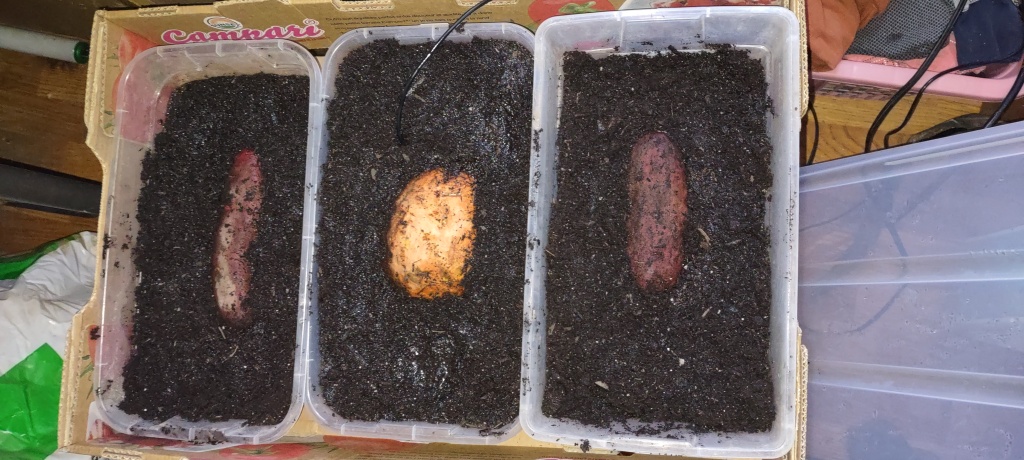
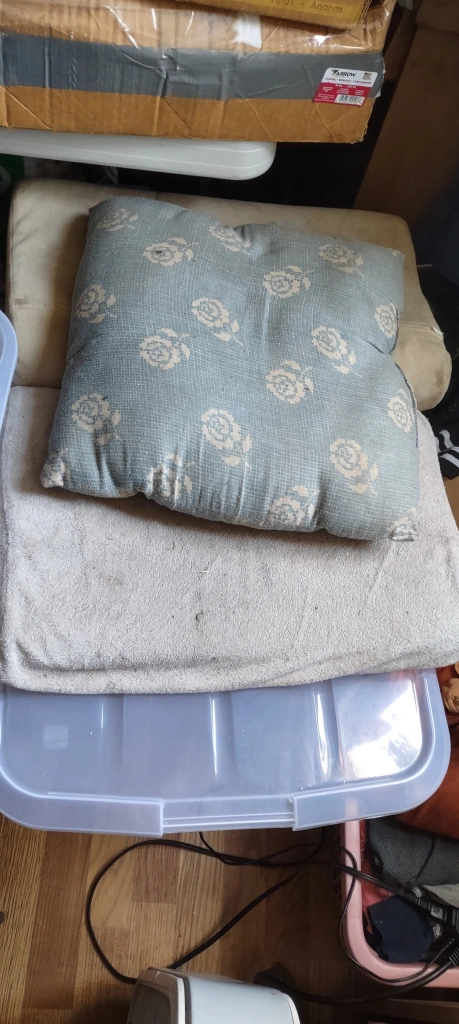







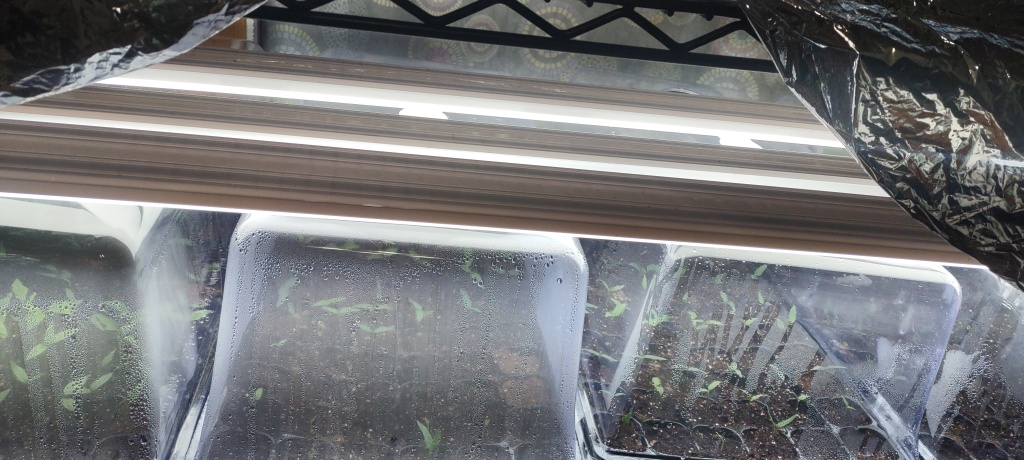
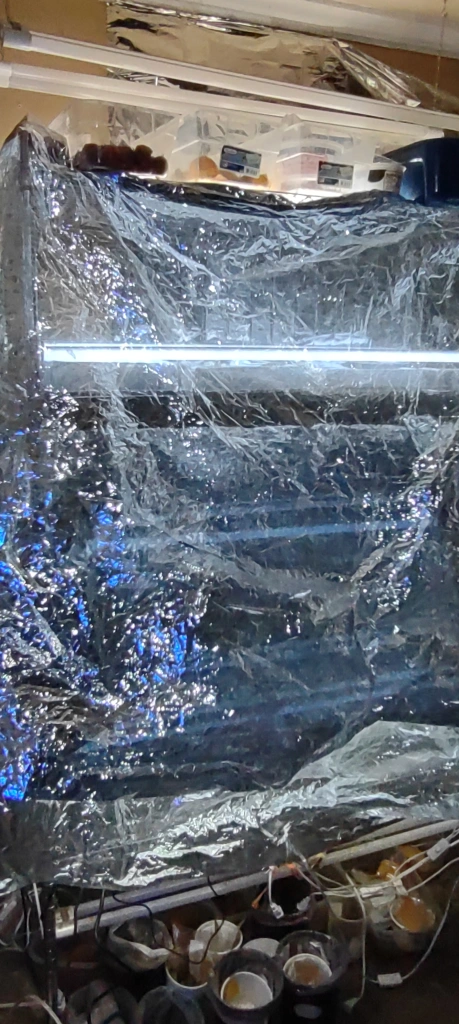


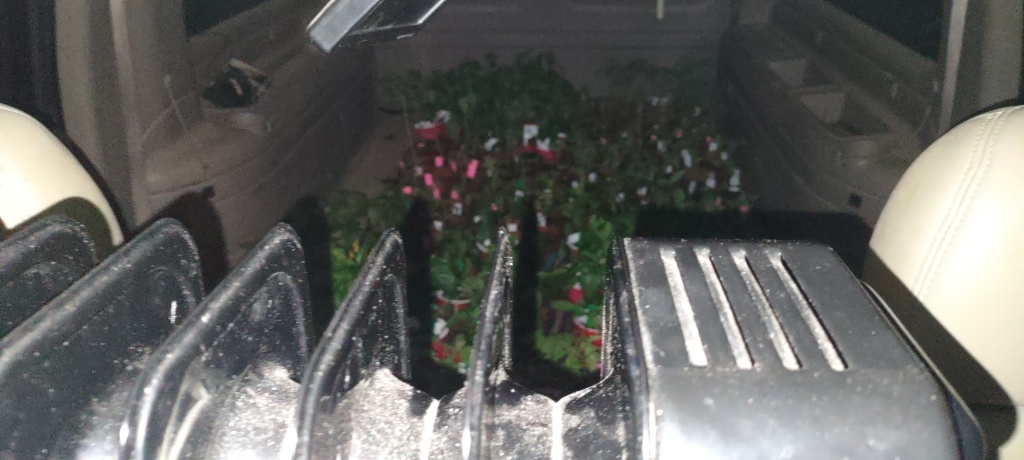




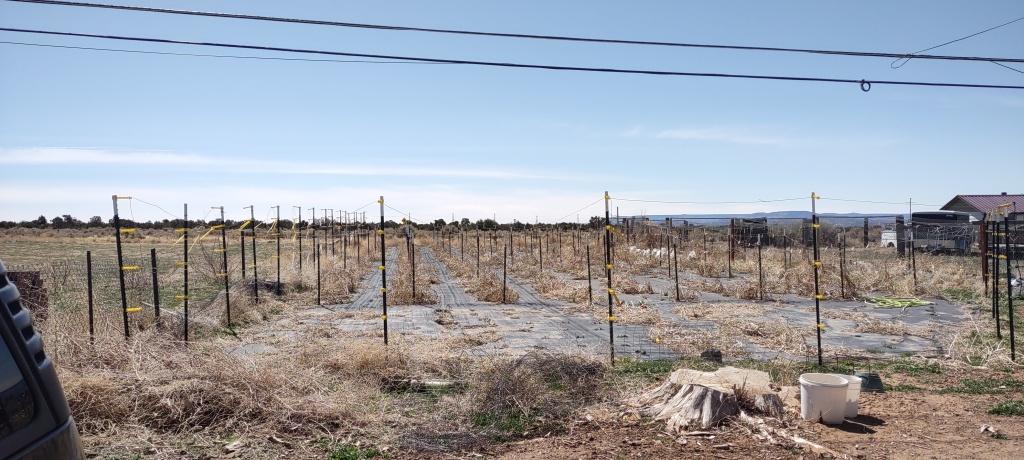



I guess I “should” be writing about seedling availability (or planting seeds, or filling seed requests); but I’ve already largely missed yet another night of sleep…
P.S.
If you are requesting free seeds (such as for a Facebook gardening group or the like), please expect a delay of several weeks or months. Except for very limited quantities in preparation for in-person seed selling events in winter, I don’t pre-package seeds (no time, no $ to hire helpers). This is a one-person operation, and it is unlikely that any person in your gardening group struggles as much as I do to make ends meet financially. “Spare time” to package seeds for giveaway is not a luxury that I have. Even after 13+ years in business, expenses remain very high and my net hourly income remains far below minimum wage in the USA – it’s more on par with wages paid in Vietnam
https://www.worlddata.info/average-income.php
https://worldpopulationreview.com/country-rankings/minimum-wage-by-country
But I don’t live in Vietnam.
Considered from another perspective, I would need to charge around $37 per seed packet (not $2.40, as is the current price) to make what the average hourly wage is in the USA – and this is assuming that I were able to sell the same number of seed packets at this much higher price. To earn what is on par with my education and decades of professional experience, I would need to charge more than $80 per packet!
“Seeds should be free” might make sense for backyard hobby gardeners and people with another source of income (a part-time job, a spouse’s job, retirement income, government subsidies, regular large donations, significant savings accounts, rental or other investment income, etc.); but I have none of these. Delectation of Tomatoes is my only source of income, and has been for many years.
P.P.S.
This is all “too much” information, especially in the realm of $ struggles. But, as in the world of professional athletes, musicians, artists, scholars, writers, scientists, and particularly entrepreneurs, intense competition is a very real thing; and “survival of the fittest” is intensely real. In all of these endeavors and many more, only those who started out with a huge head start — genetics, inheritance, a conducive environment (parents, coaches, mentors, etc.), luck — and/or those who sacrifice a great deal of the rest of their lives (as I’ve outlined above) are likely to “make the cut” and survive beyond a few months or years. Beyond developing a stubborn streak (or call it OCD or other mental illness), my “head start” was minimal and included primarily encouragement and logistical support from relatives. On the contrary, I have been stymied, impeded, even thwarted by my own personal sangsue séante d’Amazonie for nearly four decades – an ectoparasite which metamorphosed into a very focused and personal dandarabilla two decades ago. So for me, it’s more a matter of limping, crawling to the finish line, hopefully with a modicum of dignity intact; exiting with a weak, nearly silent whimper, not a blaze of glory as I once imagined. An ego conquered, crushed, obliterated. Or something of the sort..

If you need somewhere to have seedlings I am willing to host in American fork